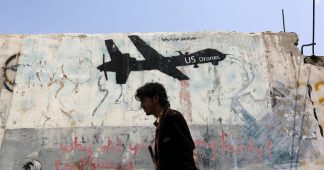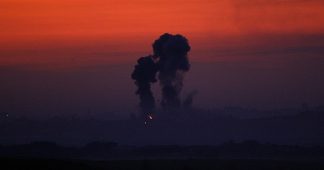In his first two years in office, Donald Trump launched 238 drone strikes in Yemen, Pakistan, and Somalia—way beyond what the ‘Drone President’ Barack Obama did.
By Spencer Ackerman
The U.S. president inherited a remotely piloted weapon of death from his predecessor. In his earliest period in office, he used this lethal robot force promiscuously, sharply escalating attacks on suspected terrorists away from his declared wars. As time went on, his use of drone strikes in those places diminished.
Barack Obama? Well, yes. But a look at available statistics for drone strikes on America’s undeclared battlefield shows that this description also applies to Donald Trump.
In 2009 and 2010, Obama launched 186 drone strikes on Yemen, Somalia, and especially Pakistan. Donald Trump’s drone strikes during his own first two years on the three pivotal undeclared battlefields, however, eclipse Obama’s—but without a corresponding reputation for robot-delivered bloodshed, or even anyone taking much notice. In 2017 and 2018 to date, Trump has launched 238 drone strikes there, according to data provided to The Daily Beast by U.S. Central Command (CENTCOM) and the drone-watchers at the Bureau of Investigative Journalism in London.
Those numbers come with a slew of asterisks. The number of drone strikes on the full-fledged acknowledged battlefields of Iraq, Afghanistan, and Syria have, ironically, proven far more difficult to track than those in shadow war zones—and knowledgeable observers like Chris Woods of the UK’s Airwars organization believe that the true center of the drone strikes is found there. Additionally, the death toll from those strikes in shadow war zones, especially of civilians, is at best a rough estimate.
A spokesperson for the National Security Council declined comment. Pentagon officials did not respond to The Daily Beast’s inquiries. But several former U.S. counterterrorism officials and practitioners point to Trump relaxing the standards Obama put in place to authorize a lethal attack in Somalia and likely elsewhere as the wellspring of an explanation.
“The burden of proof on the target was changed to a lesser burden of proof, and so that automatically opens up the aperture when you’re looking at intelligence and you have a probability factor, or a reasonable one, that your target is there,” explained retired Army Brig. Gen. Donald Bolduc, who commanded U.S. special operations forces in Africa from April 2015 to June 2017.
Under the Trump administration, the Air Force is spending more on the Hellfire missiles used by armed drones. Hellfire spending in the latter years of Obama administration briefly spiked as the Defense Department stocked up on ammunition to counter the rise of ISIS in Iraq and Syria. But even as the wars in Iraq and Syria wind down, the Trump administration has sought to purchase more drone missiles. Air Force budget documents show a 63 percent increase in Hellfire purchases in Trump’s 2017 budget and an another 20 percent increase in the most recent budget request.
A second trend also appears to be at work. The biggest escalation of the drone wars on those three battlefields under Trump came in 2017, his first year in office, followed by a substantial drop in 2018 thus far.
In 2017, Trump presided over an unprecedented 130 drone strikes in Yemen – there were 131, but one of those predated Trump’s inauguration – more than three times that of the previous year, CENTCOM told The Daily Beast. Many of those, according to the Bureau, are attributable to a substantial spike in March and April. With little over a month to go in 2018, the U.S. has launched 36 drone strikes in Yemen, CENTCOM said, nearly as many as the 38 Obama launched in his final year and the first 20 days of 2017.
“We’re not able to talk about the frequency or trends of our strikes because of its potential impact on current operations,” a CENTCOM spokesman, Maj. Josh Jacques, told The Daily Beast.
Yemen-watchers offer various explanations. Relaxed strike rules at the beginning of the administration likely ensured the military in Yemen had a wider array of strike-and-raid options. The spring 2017 drone spree coincided with a targeting focus on al Qaeda by the Saudis and Emiratis, who with U.S. support are waging a devastating war on Yemen. Afterward, neither Saudi Arabia nor the United Arab Emirates has prioritized al Qaeda—and their coalition has reportedly cut deals with those fighters against mutual foes in Yemen’s Iran-backed Houthi movement.
In Pakistan, drone strikes against suspected al Qaeda targets declined every year since Obama’s 2010 high-water mark of 128, dropping to three in 2016. Trump launched five in 2017, and only one in 2018, which killed the head of the Pakistani Taliban. But the global influence of al Qaeda’s Pakistan-based old leadership, and their allies, has declined. Pakistan’s leading politician criticizing drone strikes and U.S. counterterrorist efforts, Imran Khan, is now prime minister, and this week Khan forcefully rebuked dismissive remarks from Trump about his country. All of this raises fundamental questions about the future of drone strikes in Pakistan.
But in Somalia, where the administration in 2017 loosened restrictions on drone usage, there doesn’t appear to be much of a drop-off at all in 2018. The Trump administration is still waging a more aggressive drone campaign in the East African country than his predecessor, to minimal attention.
Trump presided over 35 strikes in Somalia in 2017. That’s two and a half times Obama’s 14 in 2016—and it eclipsed, in that single year, the 33 strikes undertaken during Obama’s entire tenure.
Thus far in 2018, the U.S. has launched 32 strikes with a month and a half to go, a U.S. Africa Command spokesperson, John Manley, told The Daily Beast. The most recent “precision strike” occurred on Monday, the command announced Tuesday; Bolduc said the term was “95 percent” likely to be a euphemism for a drone strike.
Manley offered no explanation for the strike figures. “U.S. Africa Command airstrikes conducted in support of the Federal Government of Somalia generally are opportunistic in nature, so it would be difficult to speculate on the rise and fall of the number of strikes conducted over the last two years,” he said.
But a May 2013-era Obama instruction instituted a standard of “near certainty” that a suspected senior terrorist would be present at the site of a proposed strike. Under Trump, at least for Somalia, it dropped to “reasonable certainty,” Bolduc said.
“Near certainty was a higher burden of proof. It required more platforms, different types of intelligence, HUMINT [human informants], SIGINT [surveillance intercepts], FMV [full-motion video], a lot more detail and pattern-of-life” information, Bolduc said. But he added that the Trump administration retained the Obama administration’s standards for ensuring an absence of civilians or undue damage on infrastructure—though human rights advocates have long questioned how robust a protection those standards actually provided.
“If you can say we’re not gonna have any civilian casualties, then the senior leader, a senior general officer, can say ‘OK, take the shot’,” Bolduc said. “And he’s not going to be questioned by the Pentagon or anybody else if later in the assessment the target wasn’t there but we ended up killing 8-10 al Shabaab fighters and lower level leadership.”
By and large, the military presumes that those it kills are fighters. It only investigates claims of civilian casualties after non-government organizations, partner governments, journalists or others raise concerns, Bolduc said: “The only assessment we have is we continue to fly over the objective post-strike to get a sense of the environment from the air.”
But the drone strikes occur beyond these undeclared battlefields. Chris Woods of Airwars, a leading drone-tracking organization, considers those “undeclared” battlefields to be outliers. The real epicenter of contemporary drone strikes during both the end of the Obama era and the dawn of the Trump era is the acknowledged battlefields of Iraq, Syria, and Afghanistan, where the drones are a component of Trump’s stepped-up airstrike campaigns.
Woods assesses that drone strikes have held at a steady rate from the end of the Obama era and migrated to different—and largely declared—battlefields. “Overall, the U.S. is capable only of a finite number of drone strikes a year, and I’ve seen no evidence of an overall increase under Trump—only regional variations in strike numbers year on year, as Washington pursues its conflict and counterterrorism goals,” Woods said.
Woods pointed to an astonishingly high, if largely ignored, concentration of drone strikes at the end of Obama’s tenure during a months-long campaign to wrest Sirte, in Libya, from the so-called Islamic State. An Air Force press release last year gave a rare quantification for drone strikes: about 60 percent of the 495 total airstrikes during the campaign, or roughly 297, vastly more than have ever been on offer in Pakistan, Yemen or Somalia. At the eleventh hour of his administration, in a little-noticed December 2016 document, Obama elevated Libya to a full-fledged war, more like Iraq or Afghanistan, rather than holding Libya to his own 2013-era drone-strike restrictions.
In comparison, the U.S. launched only seven anti-ISIS strikes in Libya in 2017, Samantha Reho, another spokesperson for U.S. Africa Command, told The Daily Beast. Another five have been fired against ISIS and al Qaeda targets in 2018 thus far.
In other words, when there’s a larger military campaign, the drones join the fight. That happened in the 2011 war that ousted Moammar Gadhafi. Many analysts have argued that Obama’s big drone spike in 2010 in Pakistan had a lot to do with protecting troops in his escalated war in neighboring Afghanistan. And it suggests that Trump’s escalation of general airstrikes on the acknowledged battlefields of Afghanistan, Iraq and Syria are the real focus for the drones.
“In my view, it’s not an issue of strikes intensifying under Trump. It’s about the ever-changing tempo and needs of America’s counterterrorism focus. Where America’s current counterterrorism preoccupations are, that’s where you see concentrations of drone strikes,” said Woods.
Overall airstrikes—manned and unmanned—in Afghanistan during the Trump administration reached nearly 9,600 over the past two years, a total not seen since Obama’s 2010-2011 surge, and 2018 was the single most intense year for the air war ever. June to September 2017 in Iraq and Syria represent an all-time high in that war, as well.
It’s hard to disaggregate drone strikes from those totals; the military has become less and less transparent about how it conducts its operations. In 2016, reporter Oriana Pawlyk obtained Air Force figures indicating that one out of every three sorties over Iraq and Syria was flown by a drone, and a further 17 percent of those drone sorties accounted for strikes. But it’s unknown if those percentages still apply two years later.
Luke Hartig, a former Obama administration Pentagon and White House counterterrorism official, also distinguished between the so-called “hot wars” of Iraq, Syria and Afghanistan and the shadow wars elsewhere.
“I think the story of targeted strikes and drone warfare outside areas of active hostilities across the Obama administration and the Trump administration is more of continuity than change. You’re still seeing a relatively limited number of strikes as compared to hot war zones,” Hartig said. “The big question to me is around civilian casualties. There are some indications that civilian casualties are up, but there are limitations in the outside non-governmental reporting on those and the administration has not been particularly transparent on breaking down their civilian casualty estimates outside areas of active hostilities.”
From Bolduc’s perspective, the fluctuations in drone strikes in Pakistan, Somalia and Yemen over the past two years paper over a persistent strategic incoherence that risks consigning all the death and sacrifice of a generation of war to futility.
“The big problem with this is that there’s no long-term success with this,” said Bolduc. “I’m not saying it’s not necessary to kill [terrorist] leadership, but it’s necessary to be tied into a strategy that has long-term effects and is balanced with the other things SOF [special operations forces] is doing on the ground. If it’s not, you’re not going to get to peace or good governance or improve the security environment or get to a point where they can start helping the people in these areas. You’re certainly not going to degrade the ideology by doing this.”
—with additional reporting by Adam Rawnsley











